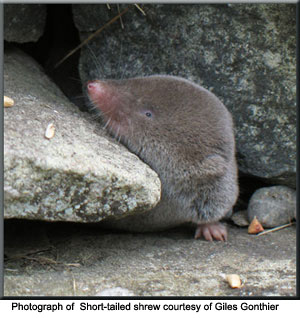Northern Short-tailed Shrew
(Blarina brevicauda)
 Description & Range:
Description & Range:
Short-tailed shrews have tiny eyes, pointed noses and a dark grayish body with a blunt tail. They are the largest shrews in North America, clocking in at a whopping 4.3 to 5.5 inches in length. These tiny critters require respect, though, as they are the only venomous mammals in the United States! Their saliva packs a potent punch to its prey in the form of a neurotoxin. Short-tailed shrews can be deadly to animals as large as frogs and small rodents, but they are not dangerous to humans or domestic animals. Short-tailed shrews still can deliver a sharp bite if handled, though!
Short-tailed shrews can be found throughout Maryland as well as much of the eastern United States and southern Canada.
Habitat:
The short-tailed shrew is one of the most common mammals in the eastern United States and can be found in forests, fields and backyards.
Diet:
Short-tailed shrews have a set of 32 teeth adapted for chewing on plants, invertebrates and other small mammals. Their favorite foods are grubs. Short-tailed shrews have a voracious appetite and tend to eat up to 3 times their body weight in food everyday. In the fall and winter, short-tailed shrews tend to hoard food, and one study found that they cache (store) as much as 87% of their food.
Reproduction:
Short-tailed shrews mate from March through September. After mating, gestation takes 21-22 days until a litter of 4-7 young are born. The young spend about 25 days in the nest before they are weaned. Short-tailed shrews can later become sexually mature at 2-3 months of age. Interestingly enough, shrews born earlier in the mating season mature faster than those born later. Shrews can have up to 3 litters of young per year.
Sounds:
During mating, male shrews will make clicking sounds to court females. Shrews also make ultrasonic noises, similar to bats, but instead of using echolocation to find food, they use it to explore their surroundings.
Behavior:
Short-tailed shrews spend much of their time underground or burrowing under leaf litter. Aside from mating, most short-tailed shrews have a solitary lifestyle and are often very territorial.
During the winter, short-tailed shrews tend to eat 40% more food in order to maintain their body temperature. Like newborns and hibernating mammals, short-tailed shrews also possess brown adipose (fat) tissue that also aids the shrew in maintaining body heat during the cold winter months.